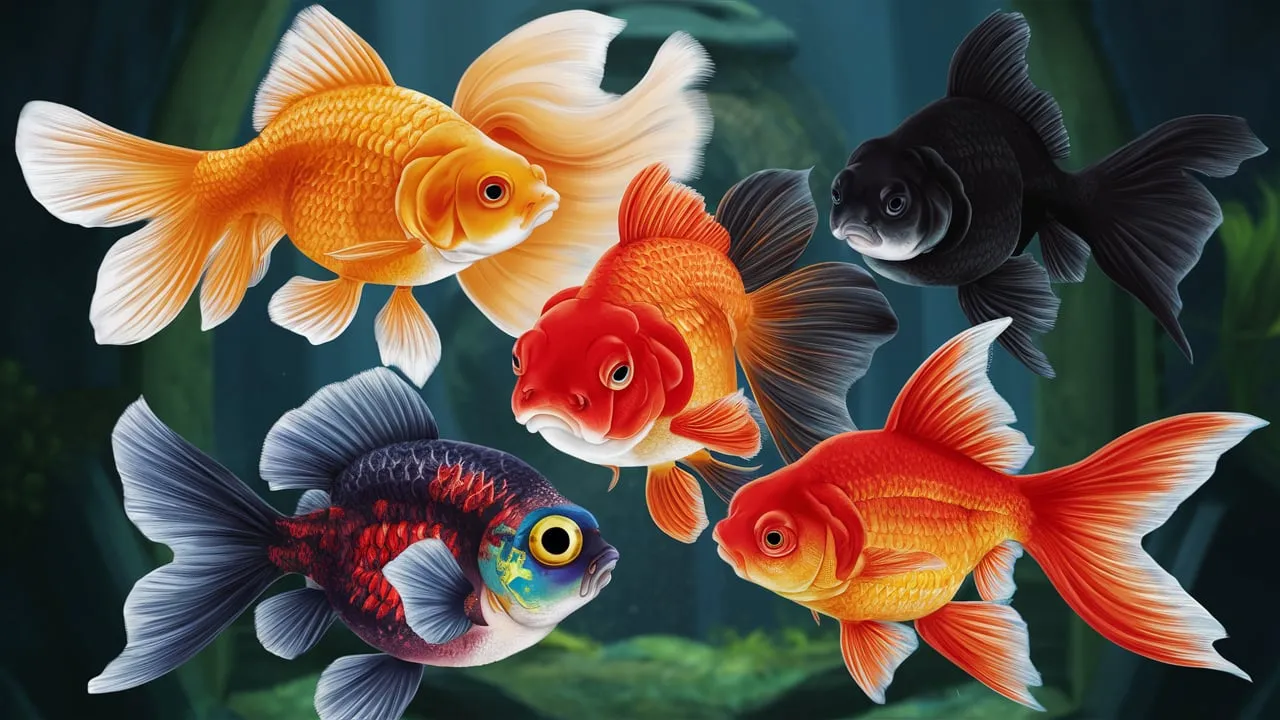Types Of Goldfish are one of the most popular aquarium fish worldwide, cherished for their vibrant colors and unique shapes. In this guide, Betta Fish Guide delve into the various types of goldfish, examining their characteristics, care requirements, and how to choose the right species for your aquarium.
A Brief History of Goldfish
Goldfish, scientifically known as Carassius auratus, have a rich history dating back to ancient China. They were first domesticated from wild carp, with the earliest recorded instances of goldfish breeding occurring during the Jin dynasty (265-420 AD). Over the centuries, Chinese breeders meticulously selected and bred goldfish, resulting in the stunning variety of breeds we see today.
Goldfish were introduced to Japan in the 16th century and quickly gained popularity. Japanese breeders further refined goldfish breeding techniques, developing new varieties and enhancing the beauty of these aquatic gems. By the 17th century, goldfish had spread to Europe, captivating the imaginations of royalty and commoners alike.
Types of Goldfish
Common Goldfish
The common goldfish is the most familiar type, known for its elongated body and vibrant orange hue. They can grow up to 12 inches in length and are generally hardy, making them ideal for beginners.
Comet Goldfish
The comet goldfish is similar to the common goldfish but has a longer, forked tail. These fish are active swimmers and can live up to 14 years with proper care.
Fantail Goldfish
The fantail goldfish features a distinctive double tail and a rounded body. Their vibrant colors and playful nature make them a popular choice among aquarists.
Ryukin Goldfish
Known for their humped back and robust body, Ryukin goldfish come in various colors and patterns. They are gentle and can thrive in community tanks.
Oranda Goldfish
The oranda goldfish is easily recognized by its wen, a fleshy growth on its head. This unique feature makes them a favorite for those looking to create a visually stunning aquarium.
Ranchu Goldfish
The ranchu goldfish is a type of fancy goldfish with a rounded body and no dorsal fin. They are known for their calm demeanor and beautiful appearance.
Bubble Eye Goldfish
With their unique bubble-like sacs beneath their eyes, bubble eye goldfish are a striking addition to any aquarium. However, they require extra care due to their delicate nature.
Telescope Goldfish
The telescope goldfish is characterized by its protruding eyes, which can make them particularly vulnerable to injury. They come in various colors and are best kept in tanks with gentle tankmates.

Choosing the Right Goldfish for Your Aquarium
With so many different types of goldfish to choose from, it’s important to consider your aquarium size, your experience level, and your personal preferences. Here are some factors to keep in mind:
- Aquarium Size: Goldfish can grow quite large, so it’s essential to choose a tank that is big enough to accommodate their size. A good rule of thumb is to provide at least 10 gallons of water per goldfish.
- Experience Level: Some goldfish breeds are more demanding than others in terms of care. Beginners may want to start with common goldfish, while experienced aquarists can explore more challenging breeds.
- Personal Preferences: Ultimately, the best goldfish for you is the one that you find most appealing. Consider the colors, shapes, and personalities of different breeds to find the perfect match for your aquarium.
Goldfish Care: Ensuring a Healthy and Happy Life
Once you’ve chosen your goldfish, it’s important to provide them with the proper care to ensure their health and happiness. Here are some key aspects of goldfish care:
- Water Quality: Goldfish are sensitive to water quality, so it’s important to maintain clean and healthy water conditions. This includes regular water changes, using a high-quality filter, and monitoring water parameters like temperature, pH, and ammonia levels.
- Diet: Goldfish are omnivores and require a balanced diet that includes both plant and animal matter. High-quality flake food, pellets, and occasional treats like bloodworms and brine shrimp can provide them with the nutrients they need.
- Tank Setup: Goldfish need a spacious tank with plenty of hiding places, plants, and decorations to create a stimulating environment. It’s also important to provide a suitable substrate, such as gravel or sand, to prevent injuries.
- Temperature: Goldfish thrive in cool water temperatures, ideally between 68°F and 72°F. Avoid placing their tank in direct sunlight or near heat sources.
Single-Tailed vs. Double-Tailed Goldfish
Goldfish can be broadly categorized into single-tailed and double-tailed varieties:
Single-Tailed Goldfish
- Include common goldfish and comet goldfish
- More streamlined and faster swimmers
- Better suited for pond environments
Double-Tailed Goldfish
- Include most fancy goldfish breeds
- Have more elaborate fin structures
- Generally slower swimmers and better suited for aquarium life
Frequently Asked Questions
What are the different kinds of goldfish?
Goldfish come in various types, including common, comet, fantail, ryukin, oranda, ranchu, bubble eye, and telescope goldfish. Each type has its unique features and care requirements.
How long do goldfish live?
With proper care, goldfish can live anywhere from 10 to 20 years, depending on the species and environmental conditions.
Can goldfish live in a bowl?
While goldfish can survive in a bowl, it is not recommended due to the limited space and poor water quality. A proper aquarium setup is essential for their long-term health.
Conclusion
Goldfish are truly fascinating creatures that can bring joy and beauty to any aquarium. By understanding their diverse varieties, care requirements, and the common questions surrounding them, you can provide your goldfish with a healthy and happy life.
Whether you’re a seasoned aquarist or just starting your aquatic journey, the world of goldfish offers endless possibilities for exploration and enjoyment.

Related Posts
Are Betta Fish Nocturnal? Mystery of Betta Sleep Patterns
Shrimp Tank Mates: Choosing The Right Companions
Are Fish Omnivores? A Look at Fish Feeding Habits